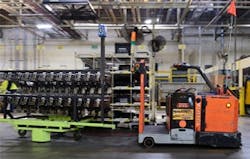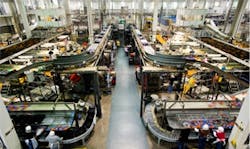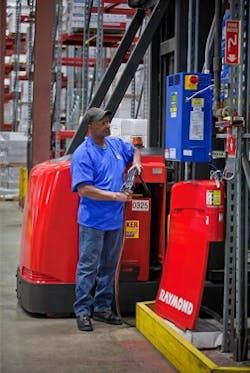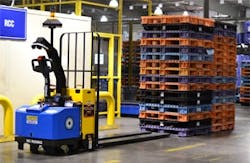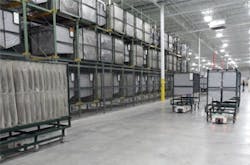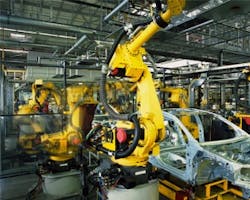Big data in the material handling industry: From supply chain to fulfillment
Big data is everywhere. Material handling professionals have witnessed a slow, almost trepid, movement into systems and software that yield levels of visibility into the equipment, processes, and products that comprise a facility’s material handling function. From the supply chain and inventory management all the way through the manufacturing process and continuing into distribution and fulfillment, increased profitability can be mined from the information that’s available.
Right-sized inventory
Dynisco, a plastics extrusion processing company with a very complex supply
chain, is a division of Roper Industries. Dynisco implemented the SyncKanban system from Synchrono to simplify its inventory replenishment and to right-size its on-hand inventory. Through this system, Dynisco has been able to track data to monitor various KPIs, including active velocity and demand variation, and to capture pull signals to help forecasting.
“Dynisco started inquiring about an electronic e-kanban system in February 2011,” explains Kevin Dailida, senior director of global supply chain and operations at Dynisco. “Prior to working at Dynisco, both John Biagioni, our president, and I were familiar with and had implemented an electronic kanban system at our prior employer. We saw positive results with the implementation of that system so we figured we would try to apply the same methodology at Dynisco.”
Dailida and Biagioni wanted to implement an e-kanban system to achieve a few objectives. “We understood that we had excess inventory, which we wanted to manage better,” says Dailida. “We are measured on our ability to control and utilize our cash appropriately; therefore excess inventory impacts the ability to invest in our business if the cash is tied up in slow-moving inventory. Alternatively, in some cases we did not always have the right number of parts at the right time, causing shortages, again tied to the ability to manage our cash flow. Therefore from a holistic standpoint we wanted to right-size our inventory in an effort to maximize our cash management from an operations standpoint.”
Dynisco also wanted to minimize the redundant transactions that the supply-chain group was performing and utilize its people in a higher-level capacity. “SyncKanban has the ability to perform the same, repetitive transactions that a buyer does,” explains Dailida. “In a lot of cases we order many of the same parts over and over again creating a lot of redundant activities. E-kanban enabled a pull signal to go directly to the supplier, eliminating the need for the purchasing transaction. At a higher level, the supply-chain group is still responsible for managing the inventory, but now they can manage the exceptions rather than the day-to-day normal transactions. It’s the exceptions that usually create the problems.”
One other benefit to implementing e-kanban was that it created the ability to track key suppliers from a delivery standpoint. “Prior to the implementation of the system, it was very difficult to measure supplier delivery performance,” says Dailida. “With the implementation of e-kanban, this has become much simpler. We can monitor our key suppliers’ performance and even drill down to specific parts that may be problematic. Again this comes back to having our supply-chain team perform analysis and manage the exceptions versus performing keystrokes.”
Dynisco has seven facilities worldwide, four in the United States and one each in Germany, China, and Malaysia, and six of them currently use SyncKanban. “As part of the SyncKanban implementation, we decided we wanted to integrate our existing Avante MRP system with the e-kanban systems,” explains Dailida. “Having two separate systems created redundancy relating to the receiving activities in addition to the potential for errors. We linked the two systems together in order to connect receiving information, as well as blanket purchase-order information. Accounting uses the Avante system as its plan-of-record system, so we wanted to make sure we didn’t create discrepancies.”
The review and interpretation of data is extremely important when implementing any kind of system (Figure 1). “The data must be reviewed, understood, and acted upon in such a way that it will not negatively impact the business,” says Dailida. “The SyncKanban system uses algorithms to evaluate inventory sizing based on the transactions or pulls that take place in the system. As history is built, the data becomes more and more aligned with the actual business patterns. Dynisco uses the kanban suggestion tool as one of the key pieces of information to properly adjust inventory levels. We evaluate the data anywhere between monthly and quarterly and make the appropriate adjustments. For example, if we evaluated the kanban suggestion information on a weekly basis and adjusted the sizes according to the suggested model, we would most likely send ripples through our supply chain, creating problems for our suppliers. The goal in right-sizing is to find a level of stability that flows back through the entire supply chain, minimizing the need for wasteful activities such as expediting or overproduction. If we don’t evaluate the information at the appropriate frequency, then we may end up with excess inventory, lower turns, and cash that we can’t convert into revenue.”
Figure 1. As history is built, the data becomes more aligned with actual business patterns, and inventory levels can be adjusted properly. Real-time visibility of material flow in a complex environment will show what can and will go wrong. (Source: Synchrono)
As it relates to the e-kanban solution, Dynisco’s two biggest KPIs are inventory turns and inventory dollars. “Not every part is suitable for e-kanban or kanban in general,” explains Dailida. “We evaluate our top 80% of spend and look for opportunities where our ordering patterns are repetitive. We utilize a plan for every part model and then track the volume of parts that are on the e-kanban system. We have also used our Avante system to flag parts that are on the e-kanban program, have potential, or are not good candidates, so the percent of e-kanban parts as it relates to the total volume of purchased parts is another metric that we are formulating and monitoring.”
The main source of data collection used by Dynisco is in the barcode and barcode reader space. “SyncKanban generates a unique kanban card number along with a part number and description that is generated in barcode form,” explains Dailida. “We have the option of keying in the data upon consumption or receipt, but utilizing the scanners and barcodes helps prevent errors due to incorrect keystrokes.”
Automated manufacturing
Automation became a hot topic when many manufacturers moved operations to countries with lower labor cost, explains Will Sobel, CEO at System Insights. “This has been reversing itself because of supply-chain costs and labor costs normalizing across the world,” he says. “As we bring manufacturing back to the United States, we need to take labor cost out of the equation when deciding where to manufacture. Automation and automated material handling become the enablers to reduce manufacturing costs and create more manufacturing jobs in the United States. This will be the differentiator when companies compete with lower-labor-cost countries and reshore manufacturing. The next generation of manufacturing, often referred to as Industry 4.0, will have more customization and shorter supply chains with local manufacturing. The transportability of manufacturing will require data and analytics to make it feasible.”
Through a contract with the National Institute of Standards and Technology (NIST), System Insights teamed with MTConnect Institute, Southwest Research Institute, and the National Center for Defense Manufacturing and Machining to prove that a read-only-based protocol and distributed control could provide a reliable and flexible platform to integrate equipment.
The advantages to this methodology were in optimization, reconfigurability, and reprogrammability. “The highly optimized system architecture means reduced BOM — control equipment — thereby reducing the cost of integration and increasing the reliability of the system,” says Sobel. “A machine tool and robot often cost two to five times as much as the cost of the robot. This methodology will reduce the cost to a fraction of the cost of the robot. A machine tool and the robot by themselves may be reliable, but, when connected together, the connecting logic and the connecting elements may not be as reliable. The system can be reconfigured dynamically and components replaced without having to replace other parts of the system. And the system can be reprogrammed rapidly and also set up to dynamically change the position of pick-and-place and alter the path to avoid interference, since the material handler is programmed using spacial coordinates instead of reteaching.”
The crux of the innovation is abstracting the task so that each piece of equipment is communicating what it needs, making a request and not a demand, explains Sobel. “It may seem like a subtle difference, but it changes the amount of information and the complexity of the inter-process communication,” he says. “The benefit is the machine tool request does not have to be synchronous with the robot. The robot can continue performing other tasks with other machines in the cell and schedule according to however it thinks it is best for the process flow. If it is a zero WIP line, the robot may wait for a downstream process to complete before loading another piece of material into the machine. If some WIP is allowed, it may realize there is a failure downstream and build up some WIP that it can push through later. The intelligence will be associated with the job and can be communicated to the robot as a set of process constraints.”
From a supervisory standpoint, since all the data required to integrate the devices is being communicated in real-time using MTConnect, any other machine or software system can monitor the interaction as it's happening. “With predictive analytics, the system can be made aware of problems before they occur and can inform the manufacturing equipment that something is going to go wrong or alert a maintenance engineer that action must be taken in the near future,” says Sobel. “As the system matures, the detailed data collected from the equipment, drives, and electrical system will provide the necessary signal to determine how to have the devices operate in the most efficient manner possible. The intelligence always needs to be pushed down from the central system to the individual pieces of equipment. The reason is scalability. If the individual pieces of equipment are capable of managing themselves, then the load on the central system is reduced and the reaction to any incident is much faster and more reliable.”
Material handling muda
Click on Tim's picture to listen to his interview with Mike Bacidore
Many of the advantages to automating material handling surround areas of throughput, the ability to give predictability, and better material tracking using RFID and barcodes when a load is transferred throughout the facility (Figure 2). “We’re able to do a much better job of tracking and ensure we’re not overproducing to a given area,” says Tim Meyer, TPS solutions and automation manager, Toyota Material Handling USA (TMHU). “With automated material handling and delivery systems, we’re able to push takt time because we’re not waiting on the human factor of material movement, but rather a computerized set program that will ensure the delivery of that material in a precise amount of time, which will give a more controlled throughput. From a manpower point of view, automating the material handling has given us the opportunity to allow customers to focus more on value-added activity at the distribution center or manufacturing plant and not focus so much on the non-value-added, or muda, which is the waste of moving product from A to B. The hurdles revolve around a situation where the manufacturer doesn’t have established material handling — standardized material movement, material tracking, data gathering. When we’re trying to go from a manual to automated delivery situation, we take the manual as a baseline. If you don’t ensure all of the manual processes are in place and all the checks and balances are in place, when you go to the automated system, it is potentially a recipe for disaster because you don’t have your base sequences in process before you begin to automate.”
Figure 2. Automated material handling allows for better predictability and tracking of throughput when a load is transferred throughout the facility (Source: Toyota Motor Manufacturing Kentucky)
As materials move through your operation, what you need is visibility. “If you’re tracking material from the supplier’s location, from when that first coil of steel was rolled into the facility to a stamping operation where they’re creating a subassembly or small part, and that part then is being shipped to a Toyota plant to be assembled onto a vehicle, by using the RFID technology, barcode technology, or QR code, you’re able to have a much better view of every piece of material, its location, and how many are in the load, and you have quality signoffs,” says Meyer. “As that material moves through your warehouse and through your plant, there’s good visibility for all aspects of the materials, and you’re addressing issues like overproduction and WIP with that additional level of control and tracking.”
But visibility isn’t the only advantage of automated material handling. “One of the main reasons customers come to us about automating their facilities with material handling systems is costs savings, especially in terms of labor,” explains Sarah Carlson, director of marketing, Daifuku Webb. “What many customers tell us after they’ve installed an automated system is they’re surprised by the cost savings in terms of inventory and infrastructure damage. For example, automatic guided vehicles, or AGVs, operate at a safe, consistent speed, which greatly reduces the number of accidents. With an automated storage and retrieval system, customers gain inventory control and floor space. In addition, automated material handling systems improve productivity and efficiency and improve processes.”
A variety of automated material handling equipment exists, so it’s important to consider all of your options. “If you think you need flexibility to make changes to your system layout or productivity levels, then automatic guided vehicles are a better choice than conveyors because you can easily change their guide path and you can add or subtract vehicles to change your productivity level,” suggests Carlson. “Unfortunately, many companies feel that automation is too expensive because of the upfront costs, but material handling equipment has become much more affordable in the past decade.”
You want a good representative sample of the current processes in order to understand and optimize them, explains Tim Talarico, senior director of design solutions, EnVista. “If you have separation of certain business segments within the four walls of a distribution center, you need to look at the data independently, or else it won’t be accurate for the overall operational process,” he says. “Never automate a poor process. Poor planning provides poor performance. Order profiles are essential to understanding the overall process and makeup of a distribution facility. If you don’t understand the process based on the data, you can’t make any supported proposals with a realistic ROI.”
Labor force
Click on Gene's picture to listen to his interview with Mike Bacidore
Automating material handling operations can provide a tremendous return on investment because it often helps improve facility productivity and reduce costs, explains Ken Fry, global OEM segment business manager, material handling, Rockwell Automation. “In many material handling applications, including conveyors, sortation, and automatic storage and retrieval systems, automation achieves higher throughput, increased pick rates, and increased SKU quantities and capacity,” he says. “Automation also can significantly reduce operational costs by lowering the amount of manual labor, boosting equipment accuracy, and improving safety and ergonomics for employees.”
Automation of material handling is being accelerated by the aging labor force (Figure 3). “A number of the plants are looking for the use of automation to better utilize the labor force they do have,” says Gene Billings, director of software products, Intelligrated. “Another consideration is the ability that automation can play to help ensure consistent cycle times. Because of new proliferation, automation systems have to be flexible. That includes robotics and new shuttle and crane technology in the United States. Some manufacturers have moved away from barcoding and moved toward RF. Big data helps to provide information back into an organization to help to boost the efficiencies of the system.”
Figure 3. The aging workforce has made way for automated solutions such as case conveyors and series palletizers. (Source: Intelligrated)
When it comes to data and material handling, it’s about the push of the information up through the machine controls and up to the equipment manufacturer’s cloud for a better understanding of how it’s working, explains Billings. “That can flow back to preventive maintenance programs and handling characteristics,” he says. “It can also be provided to the equipment manufacturer to improve future designs. We’re seeing, from the automation standpoint, it’s about labor automation. On-time shipment and availability need to be there. The picking process is often quite large. The other thing this information has is, when anomalies occur, you can handle them in a strategic way.”
Material handling falls directly into the middle of the big data discussion (Figure 4). “Our business increasingly is becoming a provider of asset and optimization services,” says Scott Craver, product manager of business and information solutions at Raymond. “With sensors streaming data from a wide range of material handling equipment, data from labor, warehouse, and time clock management systems, we can determine the most efficient and productive asset, as well as labor deployment. In order to help customers improve their internal business decisions and thus be able to create more valuable products and services for their material handling, companies are dealing directly with big data.”
Figure 4. Data from labor, warehouse, and time clock management systems can help to determine the most efficient and productive asset, as well as labor deployment. (Source: Raymond)
Big usable data
John Hayes
Click on John's picture to listen to his interview with Mike Bacidore.
Click on John's picture to listen to his interview with Mike Bacidore
Automating material handling with software and systems is what ties both sides of the big-data equation together, says John Hayes, vice president of sales and marketing, Seegrid. “In essence, it identifies efficiency losses and potential gains,” he explains (Figure 5). “There are mountains of data from the demand side — who buys, where they are located, how often — and also on the manufacturing side, from raw material demand matching to finished product rate of manufacturing. If you have data on both ends but a gulf in the center, the material handling process, it is impossible to match up the flow and identify if there is an efficiency problem that can be costing or saving companies a significant amount of money.”
Figure 5. If you have demand-side data and manufacturing data but a gulf in the center, which is the material handling process, it’s impossible to match up the flow and identify if there is an efficiency problem that can be costing or saving money. At New South Express in Lincoln, Alabama, AGVs transport empty pallets on long runs and finished goods on shorter runs. (Source: Seegrid)
All software projects become IT issues, and they require management of scope and expectation. “First-time adopters who are new to big data will likely have hardware issues due to the required capacity and will need to replace existing legacy hardware such as servers,” says Hayes. “However, with the advent of the cloud, it becomes more accessible to more companies. Accepting the intent of big data is to mine extremely large data sets to find correlations. It is not the standard. In many cases, it’s likely that the results may be counter to what you see while looking at a limited subset of data. Material handling data falls right in the middle of the big data discussion. If the two ends are monitored and mined and the middle portion is not part of the overall picture, the data set is incomplete and a true map of the process is not complete. Historically, efficiencies have begun in the manufacturing area. This has been done to not only meet demand, but to drive out costs. Once this was done, the search for efficiency and cost reduction moved to the external processes, such as warehousing and OTR trucking. Internal material handling was the last area to look for savings because the value or return appeared small compared to the gains that could be gained by speeding up processes and leaning out external costs. With the processing that big data brings, it can be shown to be a viable concept and can be refined to the point of maximum gains. But, without the inclusion of supply-chain data, a huge gulf exists.”
When you take a look at big data and the material handling data itself, in manufacturing and supply chain organizations, one of their focuses is on the flow of material through the organization, explains John Maher, vice president of product strategy, Synchrono. “In manufacturing organizations, their focus is on the improvement of that flow,” he says. “The way organizations get to a point of solid flow is to manage by exception. The material handling data can give us a lot of data about how the material is flowing. We want tools that convert that into information that help us to make executable decisions. It’s important we can convert that into usable information. We can layer information systems on top of that big data that can alert us when there are going to be problems, so they can focus on materials that are going to have issues. When something does go wrong, we need to be able to understand the causes of that flow disruption and deal with that exception in a postmortem so we can funnel it into the continuous improvement process and prevent it from happening again.”
If you’re an organization with hundreds or thousands of materials, you have a few more challenges than a plant with a limited number of raw materials creating finished goods. “Complexity may vary by the number of materials,” explains Maher. “But across all verticals, there’s quite a bit to be gained by having the supply-chain data in the organization’s information. People tend to forget the amount of churn in an organization over people constantly having to communicate and troubleshoot. If you look at the churn between purchasing and materials planning, constantly trying to stay in alignment when a simple question from customer service about delivery gets asked, that tips off an avalanche of work to look at the materials. The more you can connect that supply-chain data and automate, the more that information becomes easy to get. With exception management, if we’re collecting that supply-chain data, the information system’s alerting us when there’s a problem. If you have an organization with a complex supply chain with hundreds of transactions every day, that’s hard to stay on top of. To manage everything is to manage nothing. Look for data contextualization, so you understand the impact of the data on a given order. If you’re saying what went wrong, you can tie the transactions that impacted that order, so it’s easy to mine from the data which materials were running on a resource at a particular time. Once you can take care of the transactional level of the data, then having a good visual intuitive information system on top of that can allow the users to get to the data they want quickly.”
Big legacy
Material handling data should not fall into the discussion about big data at all, claims Floyd Dickson, vice president sales, Tutelar Technologies. “Modern software systems can easily handle the large data sets that are created within today's business,” he suggests (Figure 6). “The reason for the discussion surrounding large data sets is that legacy systems are not capable of managing today's business details. Unfortunately, most finance and MRP systems in use today are legacy systems. Fortunately, by adding a modern material handling system to manage the real-time activities of the plant floor, companies can enjoy the benefits of extensive detailed data while still feeding the legacy systems with the summaries required for financial reporting.”
Figure 6. By adding a modern material handling system, companies can compile detailed data while still feeding the legacy systems for financial reporting. (Source: Tutelar Technologies)
Connect supply-chain data. What is happening within the supply chain has significant and immediate impact on a company's ability to deliver to customers. “Real-time knowledge about what is happening within the supply chain enables a company to quickly react to problems and changes in order to minimize the impact on the operation and ensure customers’ expectations are met,” says Dickson. “Although there is some variation today as a result of legacy systems that are in place, every industry is trying to collect as much information as possible as material moves through the supply chain. We are constantly hearing about how important traceability is in most sectors, including food, drug, aerospace, automotive, and even clothing. All industries will ultimately arrive at the same point — total traceability and transparency. The key difference is how quickly each vertical industry gets there. The industries with the highest cost-of-failure are moving the fastest. These industries include food, drug, distribution, and automotive. Every company is different and has different immediate needs. Solutions exist for all aspects of material management.”
Big data’s importance in food and pharmaceutical industries is due to emerging FDA track-and-trace requirements, says Dan Hanrahan, CEO, Numina Group. The automation solution must have the connectivity tools to map order-level-detail data from the distribution center to cloud-based supply chain collaborative systems. “The key to the success of automated material handling is through design and definition of the process requirements,” he says. First, document the current process and develop a sequence of operation and flowchart of operation. Then develop the same before and after operation and flowchart the proposed automation and develop an ROI for justifying the final automated material handling process improvement, offers Hanrahan.
Information, installation, and support are hurdles to be aware of, warns Raymond’s Craver. “All systems are not created equal; most aftermarket systems provide a limited subset of data,” he says. “When you choose a system that is not integrated with material handling equipment, it doesn’t matter how many wires and sensors you hook up; you will never be able to gather key information like fault codes that you get from plug-and-play systems. Aftermarket systems are more cumbersome, expensive, and time-consuming to install, and they can be less reliable. Aftermarket systems have a long lead time to install. Once the installation is complete, you never see the installer again. This might work if you have excess capacity on-site to take full ownership of the system.”
Don’t mess with MES
Automating material handling by utilizing a manufacturing execution system (MES) can help to improve overall equipment effectiveness (OEE) within the facility (Figure 7). “State-of-the-art MES technology can track and quantify productivity gains or losses due to material handling issues across the supply chain and their impact on the OEE parameters — availability, or machine uptime; performance, or actual cycle times versus standard; and quality rates, or yield versus rejects,” explains Mohamed Abuali, chief operating officer, Forcam. “Other advantages include real-time tracking of raw material availability and inventory management, and these necessitate a proper integration of the MES with the enterprise resource planning (ERP) system. There are challenges to automating material handling processes with MES technology integration. MES must have the technical capability to integrate with the shop-floor machines’ CNCs or PLCs. MES must be certified to integrate in a bidirectional real-time mode with the top floor, or ERP. MES must be out-of-the-box to reduce lead time to deployment and offer a user-friendly Web-based access.”
Figure 7. MES technology can track and quantify productivity gains or losses due to material handling issues across the supply chain and their impact on the OEE parameters. (Source: Forcam)
Reliable and accurate integration of the MES technology to business systems is critical, especially to ERP and warehouse management system (WMS) software. “MES can download orders or operations-related information in real-time, display it to the operators on the shop floor, and integrate shop floor data from machines and assembly lines, and then send feedback and upload information to the ERP or WMS for inventory-relevant decisions across the supply chain,” explains Abuali.
Master data management (MDM) is a relatively new solution set to manage the data so there’s a single source of truth, says Mohan Ponnudurai, industry solutions director, medical device/discrete manufacturing, Sparta Systems. “Just look at the diverse set of pillar systems in a typical company — ERP, PLM, MES, document management, design tools,” he cautions. “They all have their own data back ends. When you are manufacturing, these data are pulled from various sources and then again maintained in another database. Making sure that the correct data is used as part of the final tracking, is a typical challenge and a hurdle as the users of this data are different.”
Having the supply chain data — supplier, certifications, quality standards, issue resolution history, past performance — is essential to form a cohesive and fully informed decision, not only for the current products but also for future products, explains Ponnudurai. “Fixing issues at early supply-side stages costs orders of magnitude less than when found later in the value chain, such as once in the market,” he says. “This is the Deming 1-10-100 rule. Moreover, issues that are found could lead to recalls that involve repair, replacement, image rehabilitation, and perhaps even criminal and liability costs. There are many levels of software to handle inventory management; ERP has modules to manage incoming and manufacture-stage inventory up to fulfillment and post-sales for warranty and recall purposes. Not all manufacturers use automation to manage this. Some use heavily customized solutions to manage each segment. In semiconductor manufacturing, there is a MES solution to manage all the materials and steps as part of the wafer manufacturing and then another MES is used to manage once the wafer is cut into each chip, which then goes through the packaging process.”
Metadata
From a system and software perspective, it’s crucial to have systems in place that automatically track how well a material handling system is performing overall. “What can’t be measured can’t be improved,” warns Mike Pantaleano, business manager, information and maintenance software, Rockwell Automation. “Normally, an automation system will include an HMI for alarming, but advanced data logging techniques are also needed to note if there are trends in these alarms — for example, if the nuisance alarm an operator continues to acknowledge is actually a symptom of a larger problem. These trends need to be tracked over time, along with simple items, such as conveyor motor speed and energy usage, to see if equipment is running optimally or if there are issues creeping up over time.”
Start with a small enough charter to be successful. “Many automation systems — and material handling is no exception — will fail if the charter is too big, too grandiose, or has too many moving parts,” says Pantaleano. “For brand-new systems, this can seem unavoidable, and material handling is all about mobility, but careful planning and an experienced deployment team will help. In order to retrofit existing systems, a common method is starting small and targeting improvements to specific areas to reduce pitfalls. This start-small method can also help a deployment team gain experience, but also build upon the gains of the small-start project to fund the next. A latent hurdle not easily seen is to assume that systems from many vendors can be cobbled together without completing the due diligence to know if pieces are made to work together. It’s likely that the systems will have different vendor parts involved, but this needs to stay at a manageable level of risk.”
The material handling industry has been ahead of the big data curve, says Rockwell’s Fry. “This is largely because a fully automated warehouse or distribution center needs to effectively handle a significant amount of data to function properly,” he explains. “In many facilities, warehouse management systems and warehouse control systems fulfill thousands of orders per hour by routing location information from thousands of SKUs. For companies that integrate supply-chain data, the supply chain becomes a strategic tool, rather than a cost. Providing the right, damage-free products to internal and external customers in a timely fashion has a significant impact on customer satisfaction. The use of supply-chain data allows organizations to more effectively measure and improve delivery to meet customers’ increasingly high expectations.”
Many of the same data considerations that exist on the manufacturing side transfer to the material handling side, as well. “This is because most of the data associated with a product stays with that product through the entire supply chain,” explains Fry. “This could be security and safety data associated with FDA regulations in the pharmaceutical industry or spoilage and contamination information for food products. Many warehouses and distribution centers have secure rooms for pharmaceuticals and cold rooms for certain perishable products that affect how the supply chain operates.”
Material handling data varies across vertical industries in terms of volume, velocity, variety, validity, and value — the so-called 5Vs of big data, explains Forcam’s Abuali. “The first three are generally self-defining, but validity and value are more difficult to define. By adopting the proper shop-floor-management philosophy and supporting technology, industries can ensure data is valid, as in useful, reliable, and accurate. Once they’ve done that, they can start to realize value and return on investment.”







